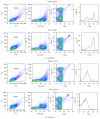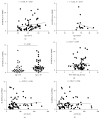Analysis of monocytic and granulocytic myeloid-derived suppressor cells subsets in patients with hepatitis C virus infection and their clinical significance
- PMID: 25815313
- PMCID: PMC4359884
- DOI: 10.1155/2015/385378
Analysis of monocytic and granulocytic myeloid-derived suppressor cells subsets in patients with hepatitis C virus infection and their clinical significance
Abstract
Myeloid-derived suppressor cells (MDSCs) have been shown to inhibit T-cell responses in many diseases, but, in hepatitis C virus (HCV) infected patients, MDSCs are still poorly studied. In this assay, we investigated the phenotype and frequency of two new populations of MDSCs denoted as monocytic and granulocytic MDSCs (M-MDSCs and G-MDSCs) in HCV infected patients and analyzed their clinical significance in these patients respectively. We found that the frequency of CD14(+)HLA-DR(-/low) cells (M-MDSCs) from HCV infected patients (mean ± SE, 3.134% ± 0.340%) was significantly increased when compared to healthy controls (mean ± SE, 1.764% ± 0.461%) (Z = -2.438, P = 0.015), while there was no statistical difference between the frequency of HLA-DR(-/low)CD33(+)CD11b(+)CD15(+) (G-MDSCs) of HCV infected patients and healthy donors (0.201% ± 0.038% versus 0.096% ± 0.026%, P > 0.05), which suggested that HCV infection could cause the proliferation of M-MDSCs instead of G-MDSCs. Besides, we found that the frequency of M-MDSCs in HCV infected patients had certain relevance with age (r = 0.358, P = 0.003); patients older than 40 years old group (mean ± SE, 3.673% ± 0.456%) had a significantly higher frequency of M-MDSCs than that of age less than 40 years old group (mean ± SE, 2.363% ± 0.482%) (Z = -2.685, P = 0.007). The frequency of M-MDSCs, however, had no correlation with HCV RNA loads, aspartate aminotransferase (AST), alanine aminotransferase (ALT), and the level of liver inflammation degree.
Figures




References
-
- Schulze zur Wiesch J., Ciuffreda D., Lewis-Ximenez L., et al. Broadly directed virus-specific CD4+ T cell responses are primed during acute hepatitis C infection, but rapidly disappear from human blood with viral persistence. Journal of Experimental Medicine. 2012;209(1):61–75. doi: 10.1084/jem.20100388. - DOI - PMC - PubMed
Publication types
MeSH terms
LinkOut - more resources
Full Text Sources
Other Literature Sources
Research Materials

